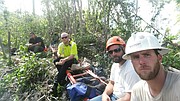Power player
PUERTO RICO — Hurricane Maria made a real mess when she rolled across Puerto Rico in late September.
“Essentially, it looked like a bomb dropped,” said Derek Schafer, Moses Lake. Schafer is a local electrical worker who is in Puerto Rico helping with the cleanup. “My crew was the first one on the island,” he added.
The path of Hurricane Maria took it right over the island, with winds in excess of 120 miles per hour. Schafer said he’s been stringing and repairing line for a couple of decades, sometimes in disaster areas that have sustained severe damage. “I’ve never seen destruction quite like this.”
Roofs were blown off, windows broken, buildings destroyed and damaged by winds, flying debris and falling trees. Roads were washed out and blocked by the fallen trees – and fallen electrical poles. “So much destruction,” he said.
“You couldn’t go anywhere without seeing power poles on the ground.” Damage to the electrical system was extensive. Many places kept the lights on with generators.
“The idea here is to is to get the power back on as soon as possible,” Schafer said. Which is easy enough to say, but it’s not all easy to accomplish.
“So much down, everywhere,” Schafer said. He estimated restoring the existing electrical service is a six-month job.
The island’s main generation sources are in the south, with transmission lines crossing the mountains. “The main artery – you have to get those up first,” he said. The storm damaged the transmission lines, but it also damaged the towers, which were already weak due to a lack of maintenance.
“The job is especially challenging.” Just getting to the lines is difficult, since there are few, if any, access roads. If there was a road, it’s likely to have lost the battle to the abundant tropical vegetation and storm damage. At many sites the only way in and out is by helicopter.
Getting there is just the first step. If the pole is broken it must be removed, because it’s less work to remove the broken pole than set a new one. “We can spend half a day or a day digging the old pole out,” Schafer said. The wire and any damaged equipment has to be removed.
The new pole has to come in – by chopper, and the helicopter also has to deliver the equipment to install the new pole. All the bits and pieces that go into building a functional electrical system, from insulators to wire, also have to be brought in by helicopter. All that material has to be brought to the island first, which adds an extra layer of complication.
And then there’s the weather. This time of year “it rains every day,” Schafer said.
Sometimes conditions on the ground are such that it’s impossible to get to ground level. That doesn’t stop the line crews. “We hang from a long line, a rope at the bottom of a helicopter,” Schafer said.
“We’ve got some amazing helicopter pilots.”
They’ve made some progress. “It’s good to see the lights come on,” he said. The crew he’s working with mostly consists of electrical workers, from central Washington, Ephrata and Wenatchee. They’ve been working together for a while, and that makes the job easier, Schafer said.
Cheryl Schweizer can be reached via email at education@columbiabasinherald.com.





